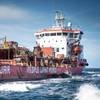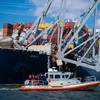The most often quoted reason for consolidation is the reduction in unit costs which can be obtained by an operator with a larger volume of business. The ways in which these reductions can be achieved in practice are discussed in a new white paper, Consolidation in the liner industry, published by Drewry.
Consolidation may put a shipping line in a better position to chart its future, with larger volumes and a greater control of its own destiny. For instance:
• CMA-CGM’s acquisition of APL leaves it in third place among the carriers (measured by capacity operated) but advances it to a share much closer to MSC and Maersk – putting the top 3 carriers in a class of their own
• COSCO and CSCL’s merger advances them to fourth place (previously sixth and seventh respectively) though around 4% points behind CMA-CGM.
Other carrier combinations could achieve comparable scale and there has been plenty of speculation around the case for shipping lines of the same nationality to merge. Any of thefollowing combinations would create a Top five carrier:
• Korea – Hanjin & Hyundai moving them to fifth place (from eighth and 15th respectively)
• Japan – MOL, NYK & K Line moving them to fifth place (from ninth, 12th and 14th respectively)
• Germany – Hapag-Lloyd & Hamburg Süd moving them to fourth place (from fifth and seventh respectively).
Leaving aside whether the shareholders of these parties are likely to reach any such agreements, these would provide an opportunity to create another shipping line of the scale approaching that of the soon to be created Top Four.
It is often argued that the most ideal M&As are where the two shipping lines have complementary geographical strengths, whether regionally or in particular trade routes, rather than just ‘doubling up’ market share in the same trades.
This rationale has been behind several previous shipping acquisitions, where strong EastWest trade presence of the acquirer has been matched with another carrier’s greater focus on North-South routes.
Maersk’s acquisition of Safmarine and Hapag-Lloyd’s of CP Ships are obvious examples, and more recently the merger of Hapag-Lloyd and CSAV looks a good ‘fit’ given the latter’s strong position in Latin America.
But the latest M&A activity offers less in the way of such complementarity, other than CMA CGM’s takeover of APL, where the former’s main strength is in its Middle East trades, which will boost the French carrier’s position in that area.
COSCO and CSCL have similar scale in most of the major trades and neither has significantshares in the north/south trades.
And looking at potential future consolidations, both a merger of the two Korean lines or the three Japanese carriers would serve to build scale in existing trades, rather than offer a broader trade base to the merged line.
Hamburg Süd is the only remaining line which has a strong North-South trade route base which would be attractive to an East-West trades focused carrier. A merger with HapagLloyd was always seen as a good fit in this respect. And despite its recent acquisition of Chilean-based CSAV, Hamburg Süd would boost Hapag-Lloyd’s position in both Australasia and South America.
The other area of potential interest to a global deep sea shipping line might be the acquisition of a specialist Intra-Asia operator. Both Wan Hai and PIL could be attractive for this reason.
In the past it has been argued that with fewer larger shipping lines there would be greater price stability and that larger lines would be able to exercise market leadership in pricing.
There has been no evidence of this having been achieved over the past 20 years and the industry remains fragmented. Even Maersk as the largest player appears to have had no success in influencing market prices from its own actions.
















